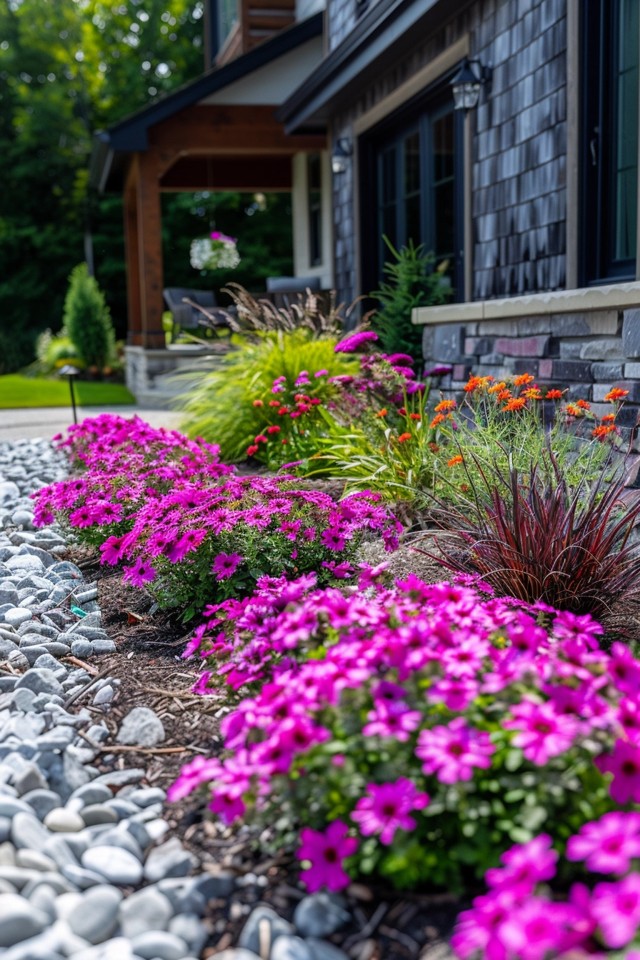If you want to add height and visual interest to your yard, consider incorporating landscape berms into your outdoor space. A berm is a rounded mound of soil that can be used in various ways to enhance your yard’s overall aesthetic. Whether you want to create privacy, block unsightly views, or simply add depth to your landscape design, there are plenty of creative berm ideas to explore.
Key Takeaways:
- Berms are rounded mounds of soil that can be used to add height and visual interest to your yard.
- They can be used to create privacy, block unsightly views, or enhance the overall aesthetic of your outdoor space.
- Consider incorporating native plants into your berm for a natural and decorative drainage solution.
- Combine berms with other landscaping elements like rocks, flowers, and shrubs to create a cohesive and beautiful landscape design.
- Get creative with the shape and size of your berms to make them unique and visually appealing.

Best Berm Plants and Gardening Tips
When it comes to designing your berm, choosing the right plants is crucial for creating a stunning and thriving landscape. Consider selecting plants that are drought-resistant and well-suited to the specific conditions of your yard. Here are some of the best berm plants that can bring color, texture, and structure to your outdoor space:
Ornamental Grasses
Grasses like hakonechloa and miscanthus are excellent choices for adding movement and texture to your berm. These graceful grasses sway in the breeze, creating a dynamic and visually appealing display.
Flowering Perennials
Hydrangeas, roses, and coneflowers are popular options for adding bursts of color and attracting pollinators to your berm. These vibrant and long-lasting flowers create a lively and eye-catching focal point in your landscape.
Evergreen Shrubs
Boxwood and juniper are versatile and hardy shrubs that can add structure and year-round interest to your berm. These evergreens provide a lush backdrop and create a sense of permanence in your outdoor space.
Deciduous Trees
Birch and spruce trees are great choices for adding height, shade, and a touch of grandeur to your berm. These majestic trees create a vertical element that complements the surrounding landscape.
Gardening on a berm requires careful consideration of soil drainage and water needs. To ensure healthy plant growth, it’s advisable to mulch or use rocks to retain moisture and suppress weed growth. Regular pruning and maintenance of the plants on your berm will help them flourish and keep your landscape looking its best.
“The right choice of plants can transform your berm into a lush and inviting oasis that enhances the visual appeal of your yard.”
So, get creative with your berm design and select the best plants that suit your style and preferences. Remember, each plant you choose contributes to the overall beauty of your landscape. By following these tips and investing time and effort into your berm gardening, you can create a captivating outdoor space that will be the envy of your neighborhood.

DIY Ideas for Residential Berms
If you’re feeling adventurous, you can create your own berms for your residential yard. It’s a fun and fulfilling project that allows you to showcase your creativity and personal style.
To get started, begin by planning the layout and size of the berms based on the available space and desired functionality. Take into consideration the overall design of your yard and how the berms can complement the existing landscape.
Next, gather the necessary materials, including soil, sand, and plant debris. These will be used to build the berm to the desired height and shape. You can consider using a combination of these materials to achieve a natural and organic look.
To add visual interest and make your berm stand out, consider incorporating natural decorations such as rocks, driftwood, or shells. These elements will give your berm a unique and eye-catching aesthetic.

Creating different levels within the berm using retaining walls or terraces can further enhance its visual appeal. This adds depth and dimension to the design, making it more interesting and dynamic.
Now it’s time to plant! Select a mix of flowers, shrubs, and grasses that thrive in your local climate and soil conditions. By carefully choosing the right plants, you can create a lush and vibrant landscape on your berm.
For added functionality, consider incorporating a pathway or stepping stones through the berm. This not only creates easy access but also adds an inviting and charming touch to your outdoor space.
Remember to regularly maintain and update the plants and decorations on your berm to keep it looking fresh and well-maintained. This will ensure that your DIY berm remains a focal point in your yard for years to come.
DIY berms offer a cost-effective way to enhance the aesthetics of your yard and create a personalized outdoor space. With some planning, creativity, and a little bit of elbow grease, you can transform your residential yard into a beautiful and inviting oasis.

